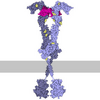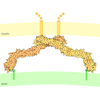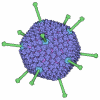[English] 日本語
 Yorodumi
Yorodumi- PDB-9u94: Cryo-EM structure of Fusobacterium nucleatum CbpF in complex with... -
+ Open data
Open data
- Basic information
Basic information
| Entry | Database: PDB / ID: 9u94 | |||||||||||||||||||||||||||
|---|---|---|---|---|---|---|---|---|---|---|---|---|---|---|---|---|---|---|---|---|---|---|---|---|---|---|---|---|
| Title | Cryo-EM structure of Fusobacterium nucleatum CbpF in complex with human CEACAM1 | |||||||||||||||||||||||||||
 Components Components |
| |||||||||||||||||||||||||||
 Keywords Keywords | CELL ADHESION / Fusobacterium nucleatum / trimeric autotransporter adhesin / CbpF / CEACAM1 | |||||||||||||||||||||||||||
| Function / homology |  Function and homology information Function and homology informationregulation of endothelial cell differentiation / insulin receptor internalization / negative regulation of cytotoxic T cell degranulation / Regulation of MITF-M dependent genes involved in invasion / granulocyte colony-stimulating factor signaling pathway / regulation of homophilic cell adhesion / negative regulation of hepatocyte proliferation / filamin binding / regulation of epidermal growth factor receptor signaling pathway / regulation of blood vessel remodeling ...regulation of endothelial cell differentiation / insulin receptor internalization / negative regulation of cytotoxic T cell degranulation / Regulation of MITF-M dependent genes involved in invasion / granulocyte colony-stimulating factor signaling pathway / regulation of homophilic cell adhesion / negative regulation of hepatocyte proliferation / filamin binding / regulation of epidermal growth factor receptor signaling pathway / regulation of blood vessel remodeling / regulation of sprouting angiogenesis / negative regulation of natural killer cell mediated cytotoxicity directed against tumor cell target / negative regulation of lipid biosynthetic process / negative regulation of T cell mediated cytotoxicity / regulation of endothelial cell migration / negative regulation of granulocyte differentiation / regulation of phosphatidylinositol 3-kinase/protein kinase B signal transduction / insulin catabolic process / Fibronectin matrix formation / common myeloid progenitor cell proliferation / : / negative regulation of interleukin-1 production / positive regulation of vasculogenesis / negative regulation of fatty acid biosynthetic process / negative regulation of platelet aggregation / bile acid transmembrane transporter activity / negative regulation of vascular permeability / regulation of immune system process / wound healing, spreading of cells / negative regulation of T cell receptor signaling pathway / bile acid and bile salt transport / transport vesicle membrane / blood vessel development / microvillus membrane / homophilic cell-cell adhesion / tertiary granule membrane / lateral plasma membrane / regulation of ERK1 and ERK2 cascade / specific granule membrane / negative regulation of protein kinase activity / basal plasma membrane / regulation of cell migration / protein tyrosine kinase binding / integrin-mediated signaling pathway / Cell surface interactions at the vascular wall / adherens junction / regulation of cell growth / kinase binding / cellular response to insulin stimulus / cell-cell junction / cell junction / cell migration / actin binding / angiogenesis / protein phosphatase binding / calmodulin binding / protein dimerization activity / cell adhesion / apical plasma membrane / Neutrophil degranulation / cell surface / signal transduction / protein homodimerization activity / extracellular exosome / identical protein binding / membrane / plasma membrane Similarity search - Function | |||||||||||||||||||||||||||
| Biological species |  Fusobacterium nucleatum (bacteria) Fusobacterium nucleatum (bacteria) Homo sapiens (human) Homo sapiens (human) | |||||||||||||||||||||||||||
| Method | ELECTRON MICROSCOPY / single particle reconstruction / cryo EM / Resolution: 2.11 Å | |||||||||||||||||||||||||||
 Authors Authors | Li, L.J. / Shen, F. / Zhao, X. / Gao, G.F. | |||||||||||||||||||||||||||
| Funding support |  China, 1items China, 1items
| |||||||||||||||||||||||||||
 Citation Citation |  Journal: To Be Published Journal: To Be PublishedTitle: Structural basis of Fusobacterium nucleatum CbpF binding to human CEACAM1 and CEACAM5 Authors: Shen, F. / Li, L.J. / Zhao, X. / Gao, G.F. | |||||||||||||||||||||||||||
| History |
|
- Structure visualization
Structure visualization
| Structure viewer | Molecule:  Molmil Molmil Jmol/JSmol Jmol/JSmol |
|---|
- Downloads & links
Downloads & links
- Download
Download
| PDBx/mmCIF format |  9u94.cif.gz 9u94.cif.gz | 214.6 KB | Display |  PDBx/mmCIF format PDBx/mmCIF format |
|---|---|---|---|---|
| PDB format |  pdb9u94.ent.gz pdb9u94.ent.gz | 168.1 KB | Display |  PDB format PDB format |
| PDBx/mmJSON format |  9u94.json.gz 9u94.json.gz | Tree view |  PDBx/mmJSON format PDBx/mmJSON format | |
| Others |  Other downloads Other downloads |
-Validation report
| Summary document |  9u94_validation.pdf.gz 9u94_validation.pdf.gz | 970.3 KB | Display |  wwPDB validaton report wwPDB validaton report |
|---|---|---|---|---|
| Full document |  9u94_full_validation.pdf.gz 9u94_full_validation.pdf.gz | 975.4 KB | Display | |
| Data in XML |  9u94_validation.xml.gz 9u94_validation.xml.gz | 40.1 KB | Display | |
| Data in CIF |  9u94_validation.cif.gz 9u94_validation.cif.gz | 59.6 KB | Display | |
| Arichive directory |  https://data.pdbj.org/pub/pdb/validation_reports/u9/9u94 https://data.pdbj.org/pub/pdb/validation_reports/u9/9u94 ftp://data.pdbj.org/pub/pdb/validation_reports/u9/9u94 ftp://data.pdbj.org/pub/pdb/validation_reports/u9/9u94 | HTTPS FTP |
-Related structure data
| Related structure data |  63959MC  9u93C M: map data used to model this data C: citing same article ( |
|---|---|
| Similar structure data | Similarity search - Function & homology  F&H Search F&H Search |
- Links
Links
- Assembly
Assembly
| Deposited unit | 
|
|---|---|
| 1 |
|
- Components
Components
| #1: Protein | Mass: 35874.555 Da / Num. of mol.: 3 Source method: isolated from a genetically manipulated source Source: (gene. exp.)  Fusobacterium nucleatum (bacteria) / Production host: Fusobacterium nucleatum (bacteria) / Production host:  #2: Protein | Mass: 15913.442 Da / Num. of mol.: 3 Source method: isolated from a genetically manipulated source Source: (gene. exp.)  Homo sapiens (human) / Gene: CEACAM1, BGP, BGP1 / Production host: Homo sapiens (human) / Gene: CEACAM1, BGP, BGP1 / Production host:  Has protein modification | N | |
|---|
-Experimental details
-Experiment
| Experiment | Method: ELECTRON MICROSCOPY |
|---|---|
| EM experiment | Aggregation state: PARTICLE / 3D reconstruction method: single particle reconstruction |
- Sample preparation
Sample preparation
| Component | Name: Fusobacterium nucleatum CbpF in complex with human CEACAM1 Type: COMPLEX / Entity ID: all / Source: MULTIPLE SOURCES |
|---|---|
| Source (natural) | Organism:  Fusobacterium nucleatum (bacteria) Fusobacterium nucleatum (bacteria) |
| Source (recombinant) | Organism:  |
| Buffer solution | pH: 8 |
| Specimen | Embedding applied: NO / Shadowing applied: NO / Staining applied: NO / Vitrification applied: YES |
| Vitrification | Cryogen name: ETHANE |
- Electron microscopy imaging
Electron microscopy imaging
| Experimental equipment |  Model: Titan Krios / Image courtesy: FEI Company |
|---|---|
| Microscopy | Model: TFS KRIOS |
| Electron gun | Electron source:  FIELD EMISSION GUN / Accelerating voltage: 300 kV / Illumination mode: FLOOD BEAM FIELD EMISSION GUN / Accelerating voltage: 300 kV / Illumination mode: FLOOD BEAM |
| Electron lens | Mode: BRIGHT FIELD / Nominal defocus max: 1800 nm / Nominal defocus min: 1200 nm |
| Image recording | Electron dose: 40 e/Å2 / Film or detector model: FEI FALCON IV (4k x 4k) |
- Processing
Processing
| EM software | Name: PHENIX / Version: 1.20.1_4487 / Category: model refinement |
|---|---|
| CTF correction | Type: PHASE FLIPPING AND AMPLITUDE CORRECTION |
| 3D reconstruction | Resolution: 2.11 Å / Resolution method: FSC 0.143 CUT-OFF / Num. of particles: 430775 / Symmetry type: POINT |
| Refinement | Highest resolution: 2.11 Å Stereochemistry target values: REAL-SPACE (WEIGHTED MAP SUM AT ATOM CENTERS) |
 Movie
Movie Controller
Controller



 PDBj
PDBj





